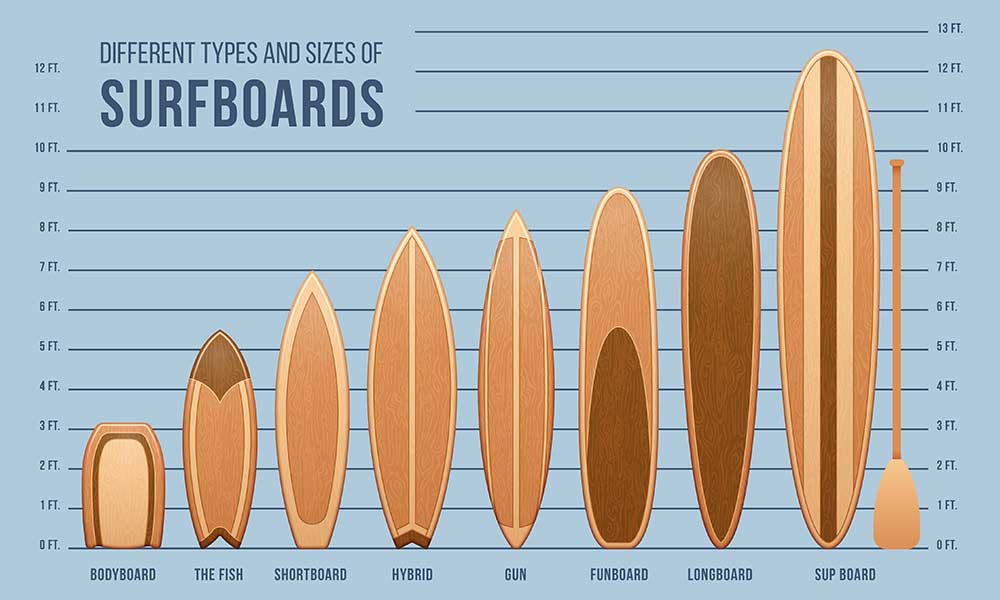There are surfboards to suit every style and every wave; everything is customizable but even the basic templates are diverse.
The different types of surfboards are:
- The Longboard
- The Shortboard
- The Fish
- The Malibu
- The Rhino Chaser
- Noserider Longboard
- Groveler
- Stand-up Paddleboard
Let’s get into the details of the different types of surfboards.
The Longboard Surfboard
A longboard is a classic surfboard that’s typically over 9′ in length, with wide tails and a blunt nose.
The size of these surfboards makes them incredibly buoyant and allows for easier paddling, making them better suited to beginners.
However, they lack the speed and sharpness of shortboards and are usually reserved for small surf.
The Shortboard Surfboard
Shortboards are the most popular surfboards by quite a stretch, and if you visit your local beach, you’ll find that the majority of experienced surfers are using these surfboards.
Shortboards are between 5’5 and 6’5 and the shorter length allows for greater maneuverability and easier duck diving.
The downside is that it’s difficult to paddle and can be harder for a beginner to remain in control.
Most shortboards use a three-fin setup but a surfboard can have any kind of fin setup and still be considered a shortboard.
The Fish Surfboard
Similar to Shortboards, Fish surfboards are great for small to medium waves, with smooth planing and fantastic speeds.
They are wider than standard Shortboards and get their name from the fish-type tail.
The Fishboard was developed by a kneeboarder named Steve Lis, who was just 16-years-old when he conceived this game-changing board.
The Malibu Surfboard
What was once known as a “funboard” and more recently a “mid-length”, the Malibu is a hybrid of the Longboard and Shortboard, striking a fine balance between the two and creating something that can be used by beginners and more experienced surfers.
It’s not the best option for professional surfers hitting big waves, but it’s a good option to have on standby for those simple summer surfs.
The Rhino Chaser Surfboard
The Rhino Chaser is a shortboard that errs on the large side and is said to have been invented by Pat Curren, a big wave surfer and an expert shaper.
Although they are easy to paddle and capable of handling big waves, these surfboard lack the turning capabilities of smaller boards and their size can vary quite considerably.
Guns are not for the feint-of-heart and are best left for the experts.
Noserider Longboard Surfboard
First designed in the 1960s, the Noserider surfboard was built for noseriding (no surprise there!) and is great for small to medium waves.
Often around 10′ in length, this Longboard has a wide, full nose and a single-fin.
Groveler Surfboard
The popularity of Groveler surfboards has increased considerably over the last decade or so, but it has been argued that the invention of this surfboard goes back over half a century.
These fat surfboard are great for getting up to speed and are suited to smaller waves.
They are also very lightweight and easy to carry.
Stand-up Paddleboard Surfboard
A SUP made for surfing is a large, thick, and buoyant surfboard that can be as long as 12′ and is designed for very small waves, as well as flat-water sports.
Stand-up Paddleboards are accompanied by a paddle that the rider uses to push through the water, similar to the ancient paddle crafts once popular throughout Polynesia and Africa.
Which surfboard is Right For You?
Your experience level and the type of surf you’re riding will dictate which surfboard is right for you.
Longboards, especially foamies, tend to be more suited to beginner surfers; Shortboards are better for professionals and more accomplished surfers.
But there are many variables and these need to be considered before you make that purchase.
If you are looking to compare surfboard types check out:







